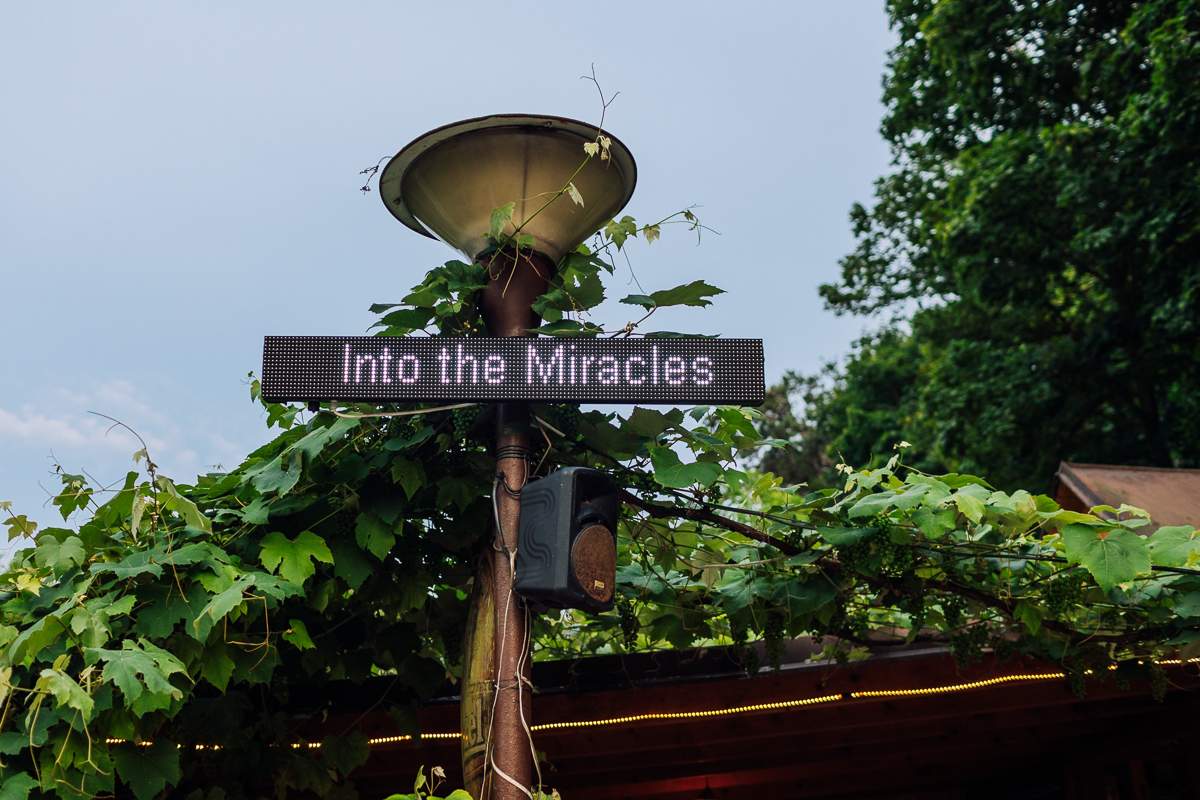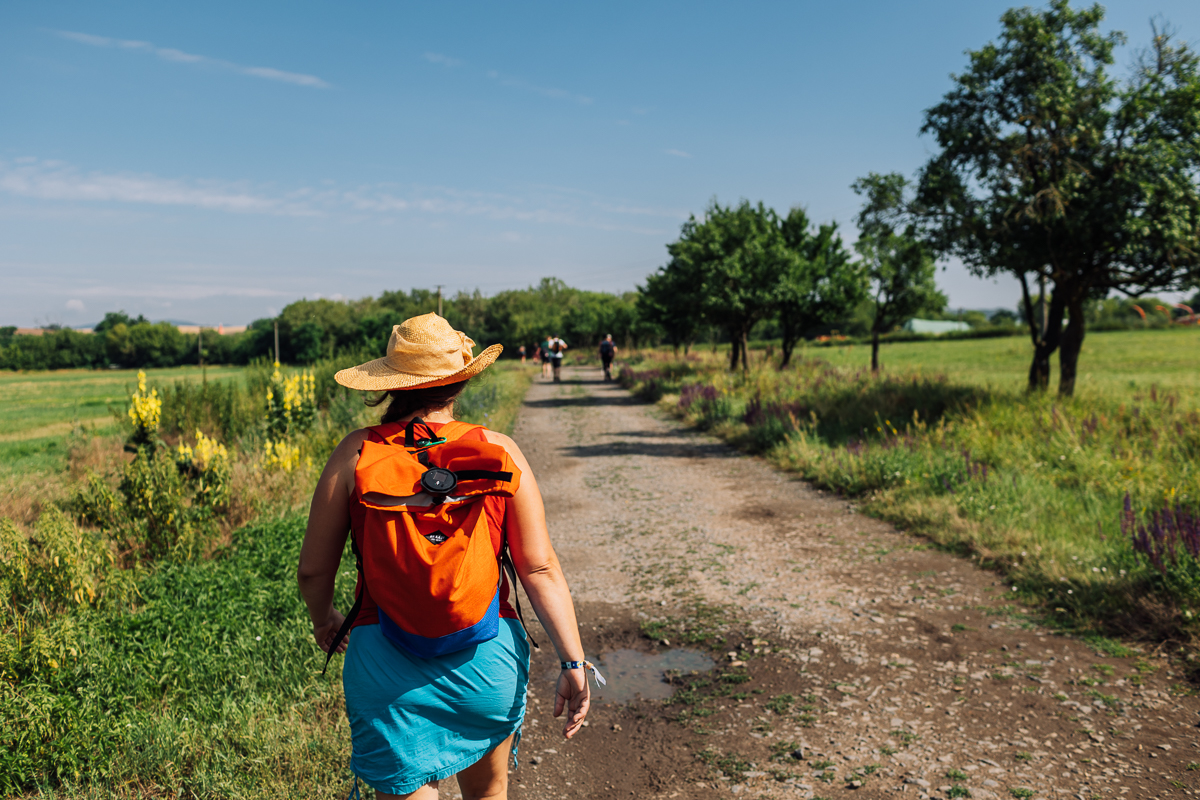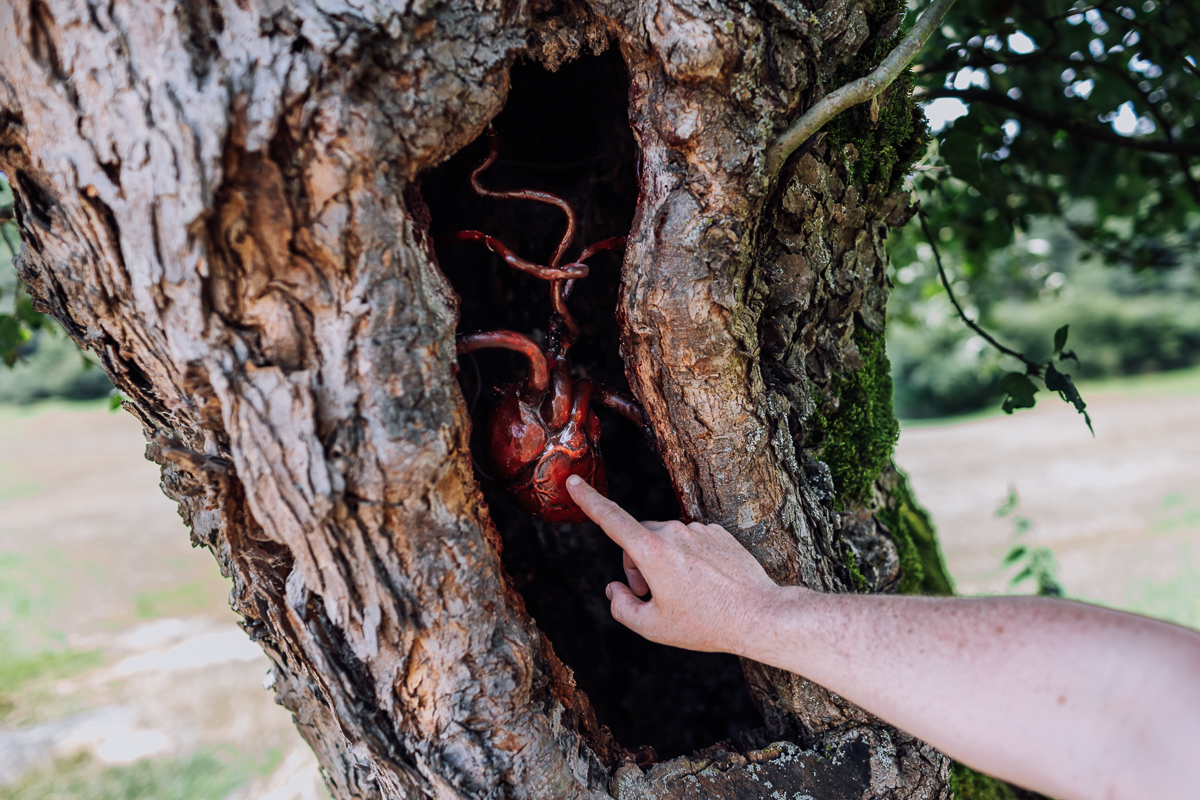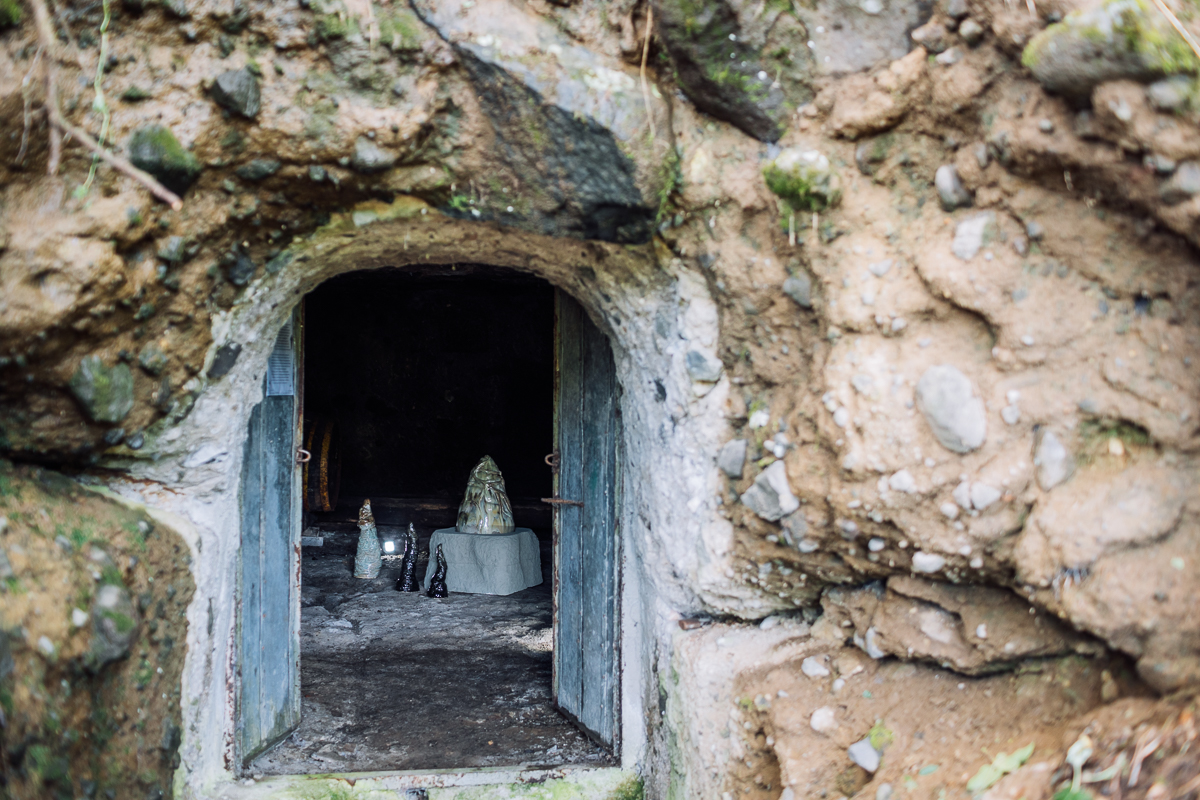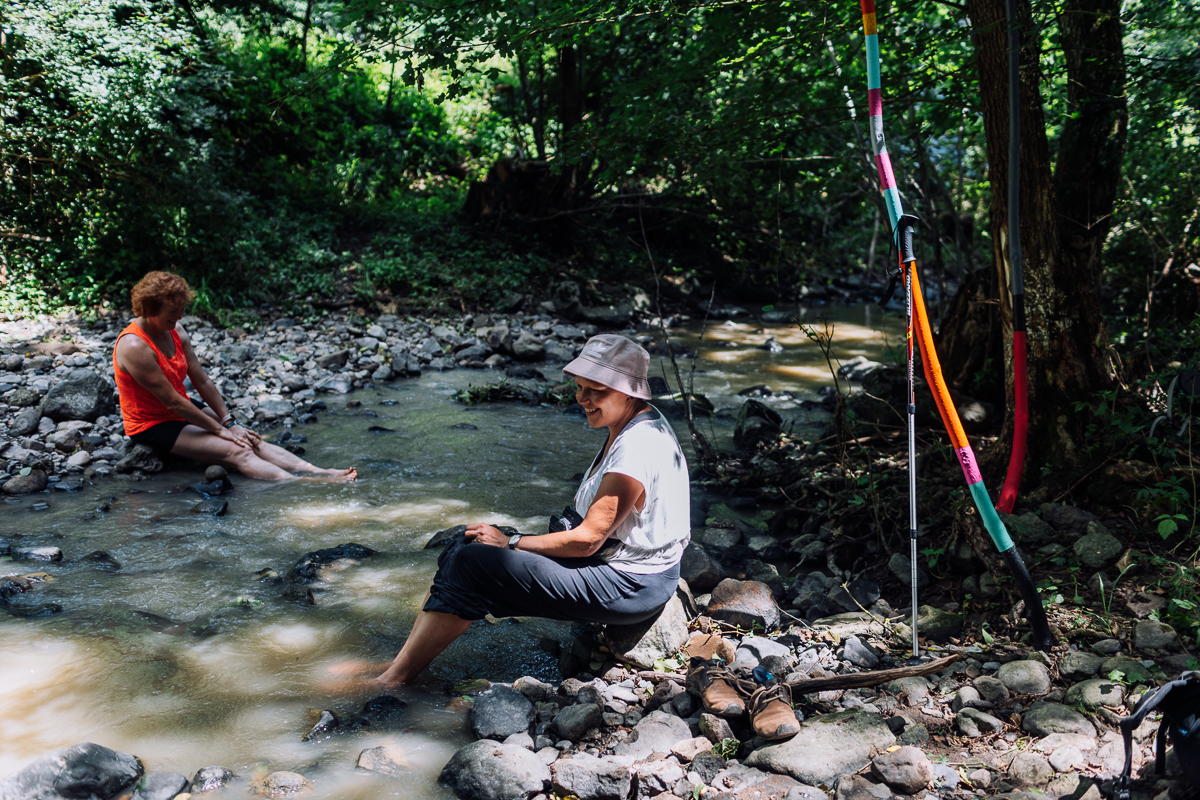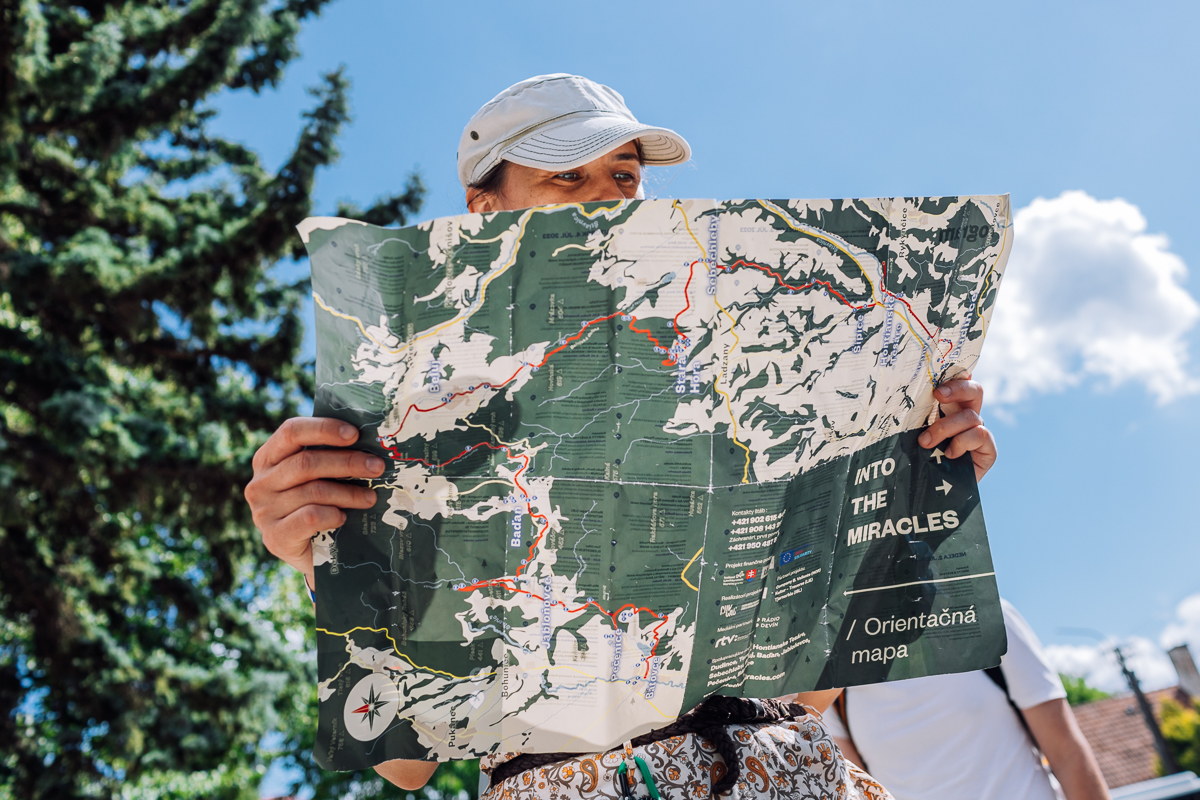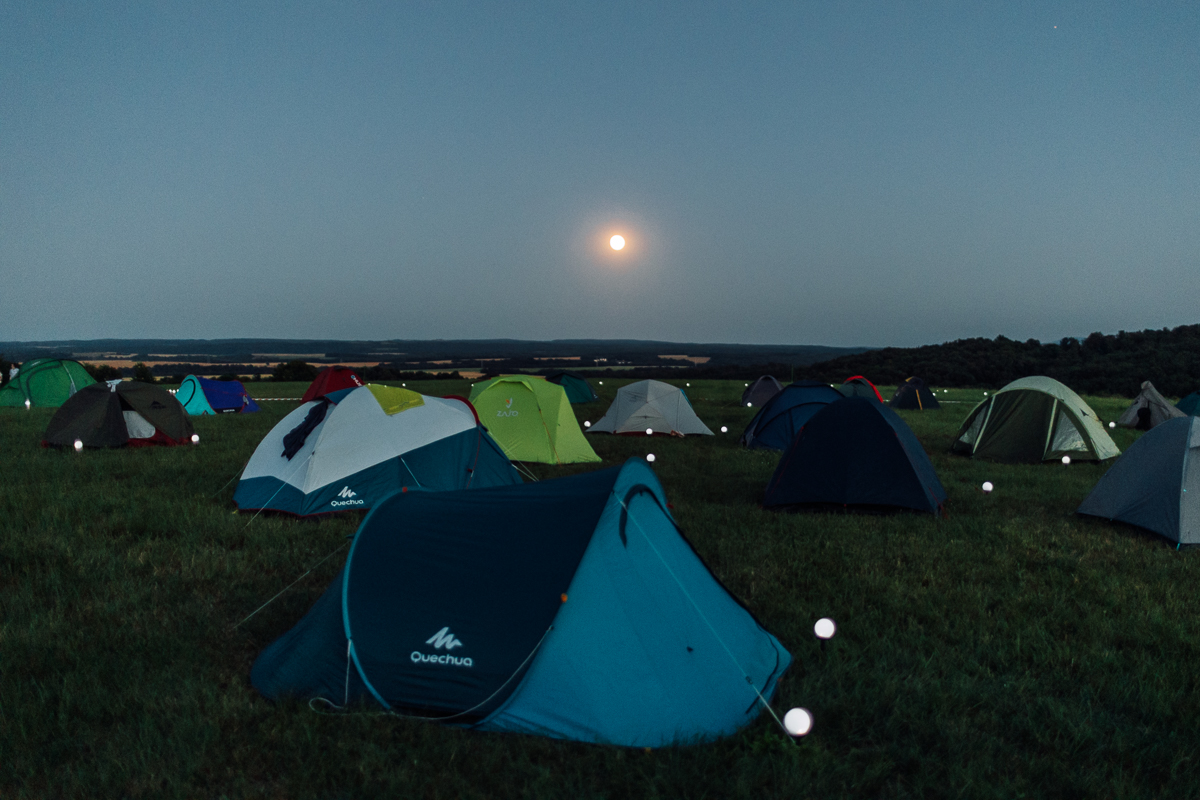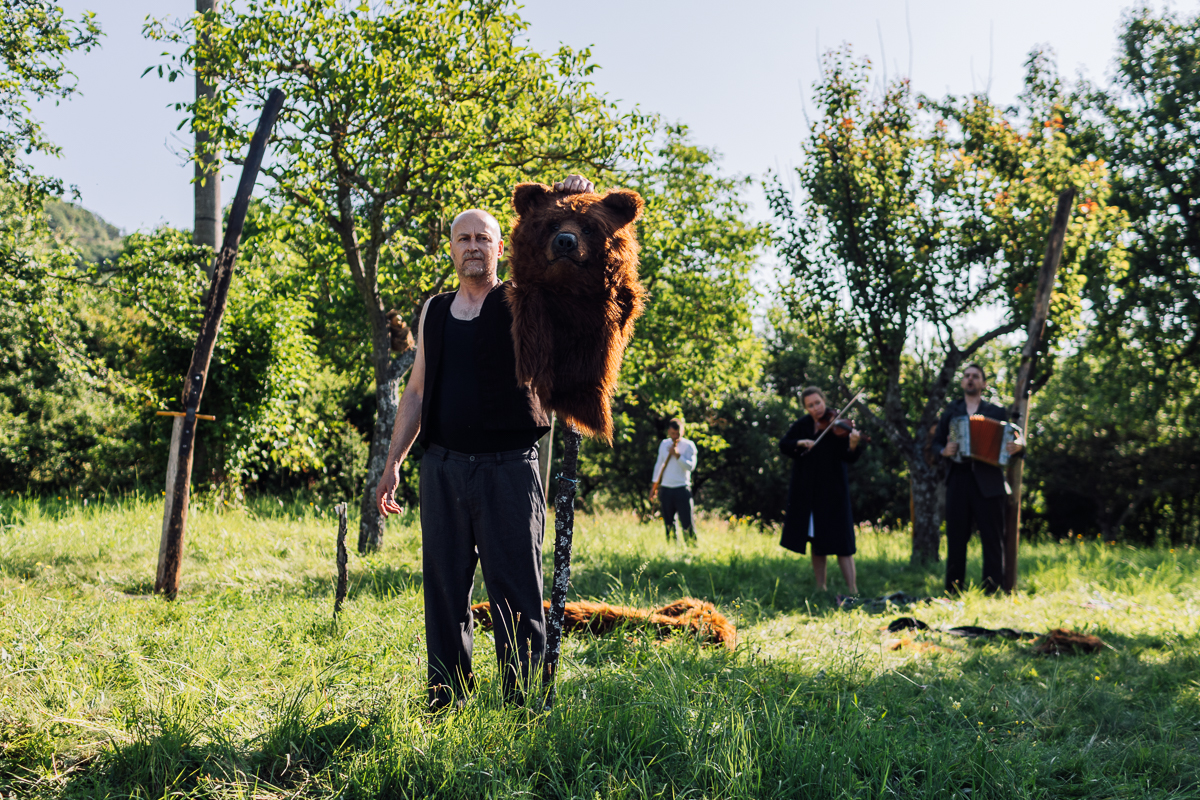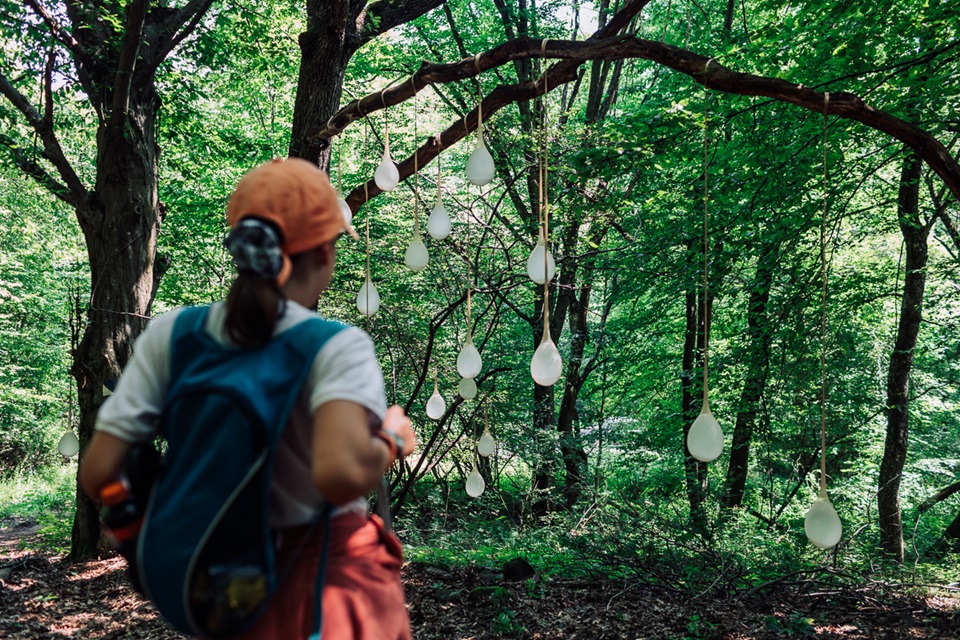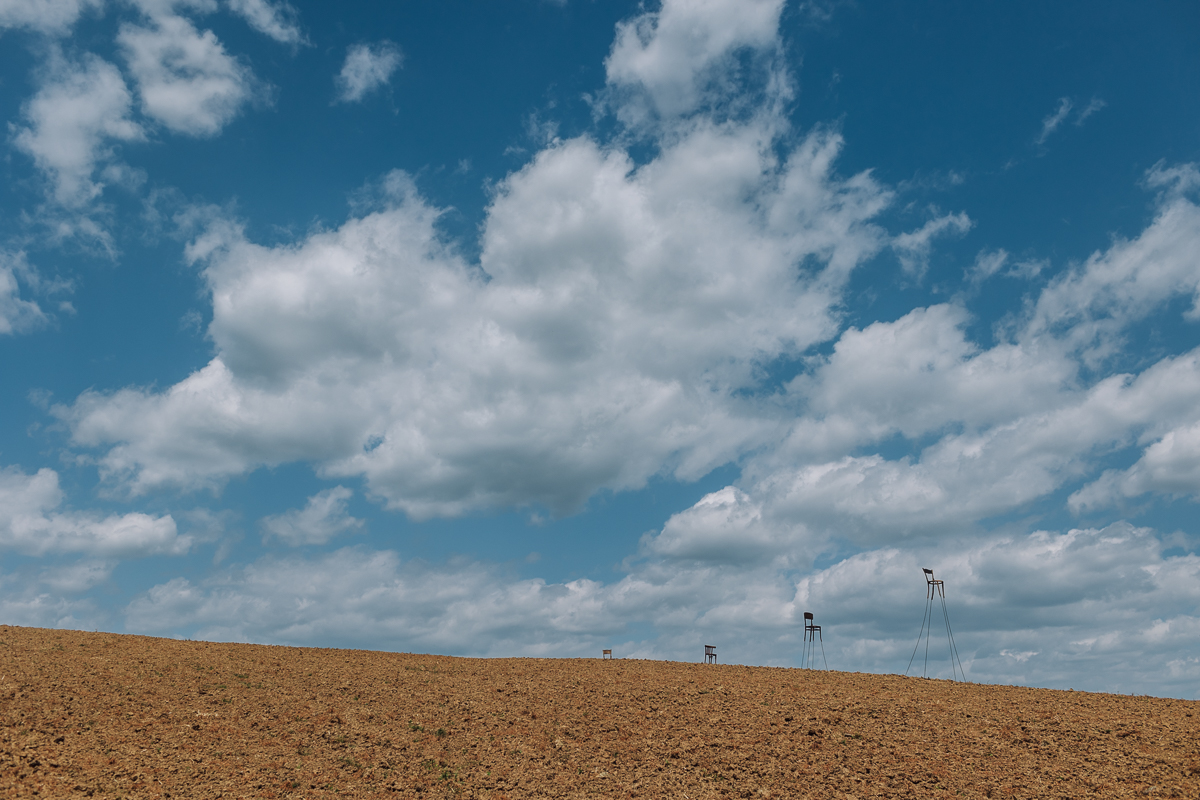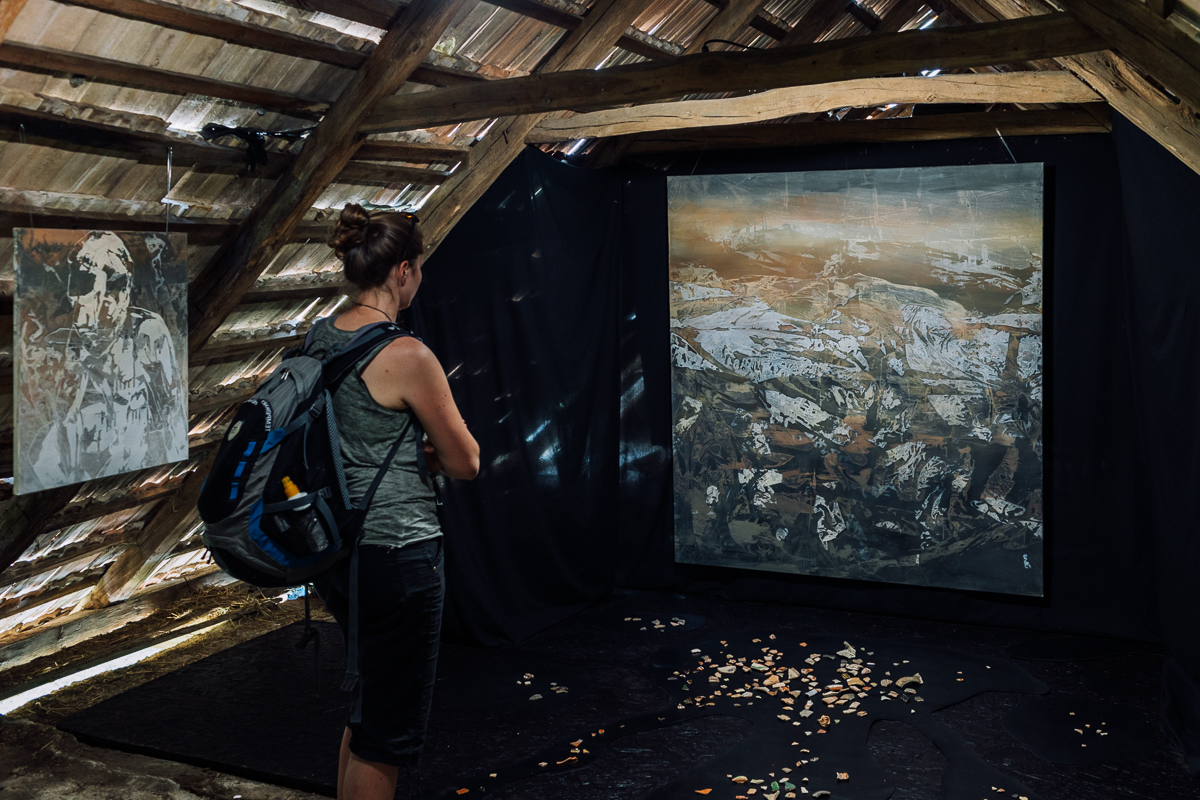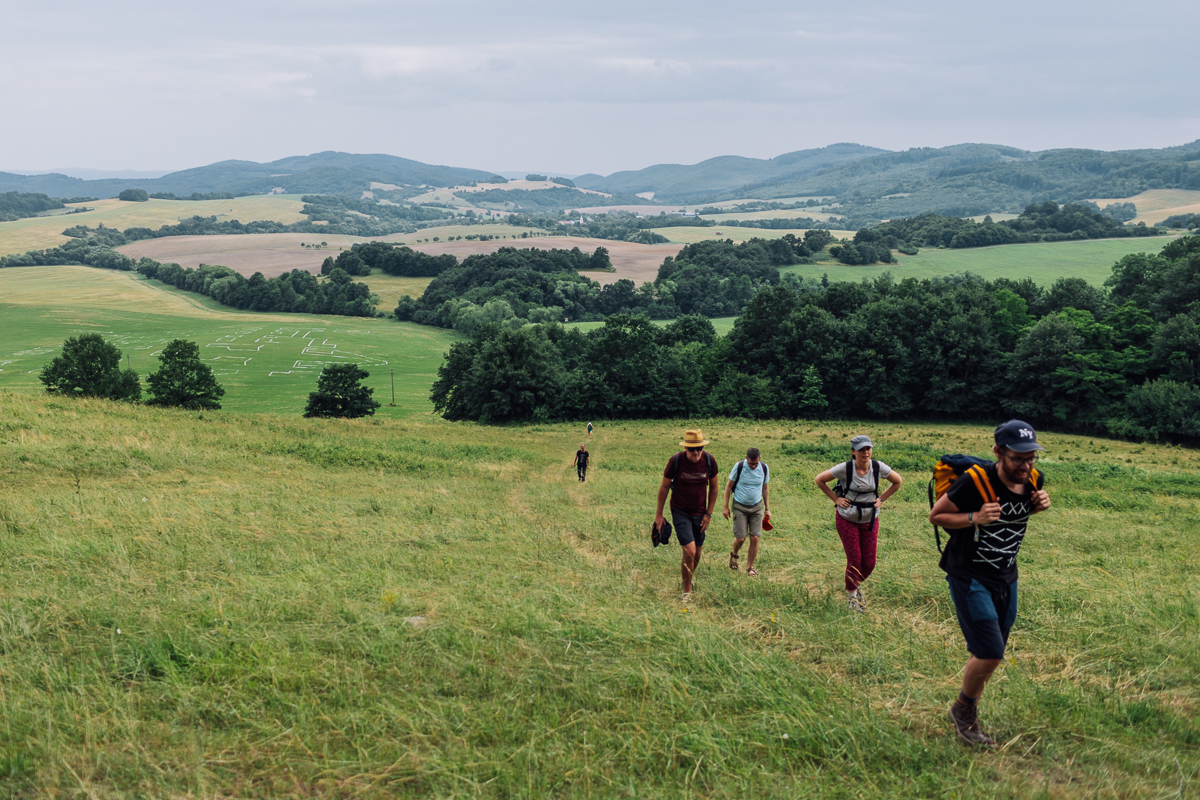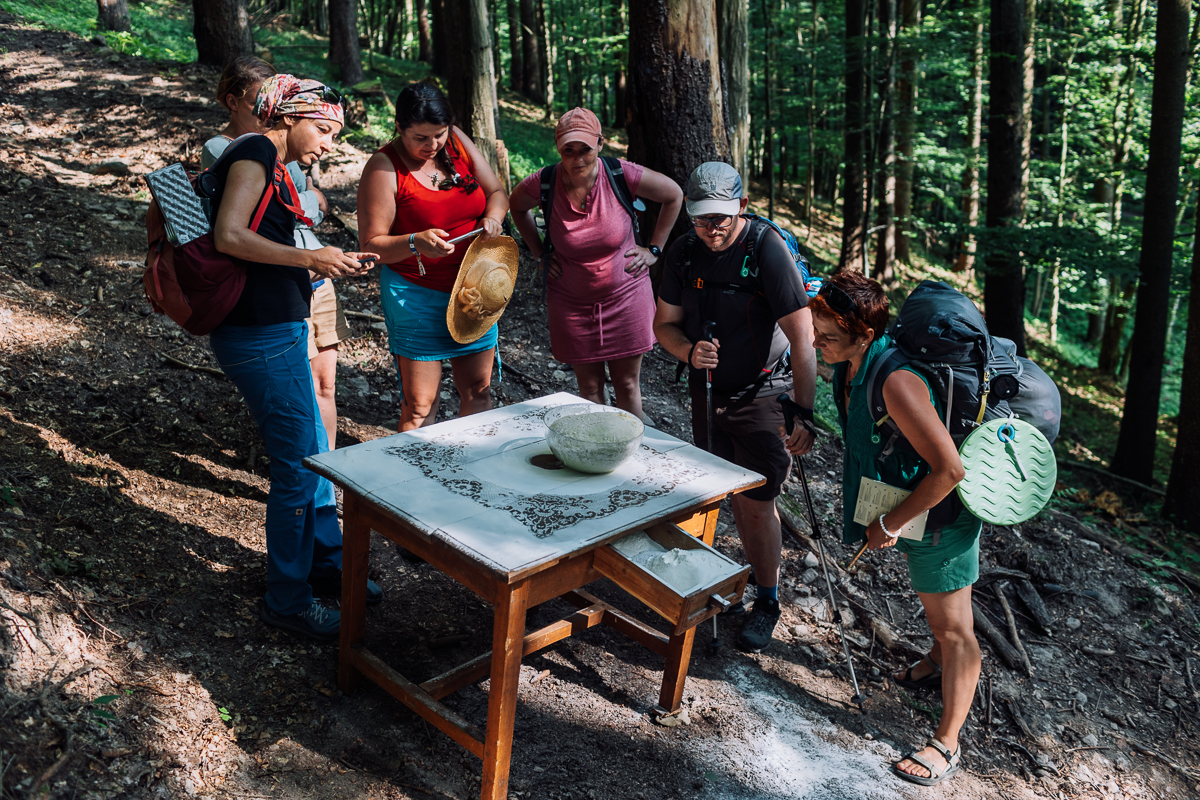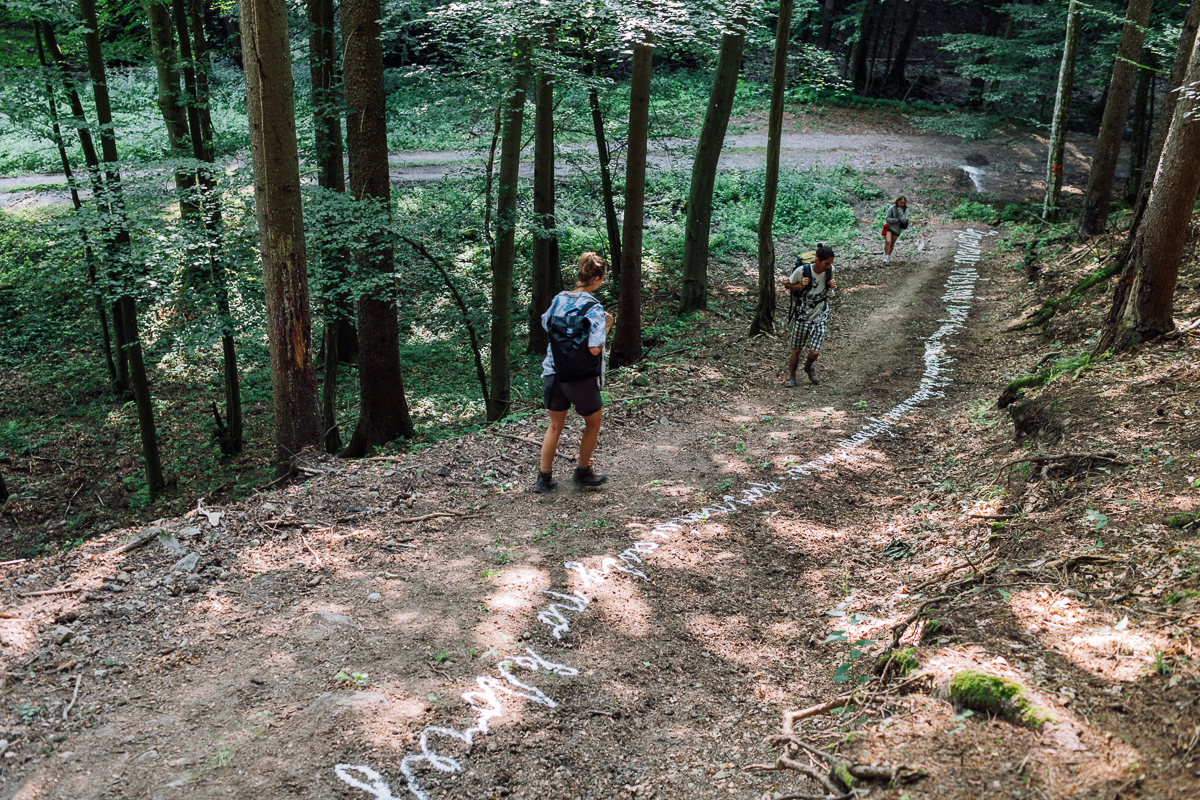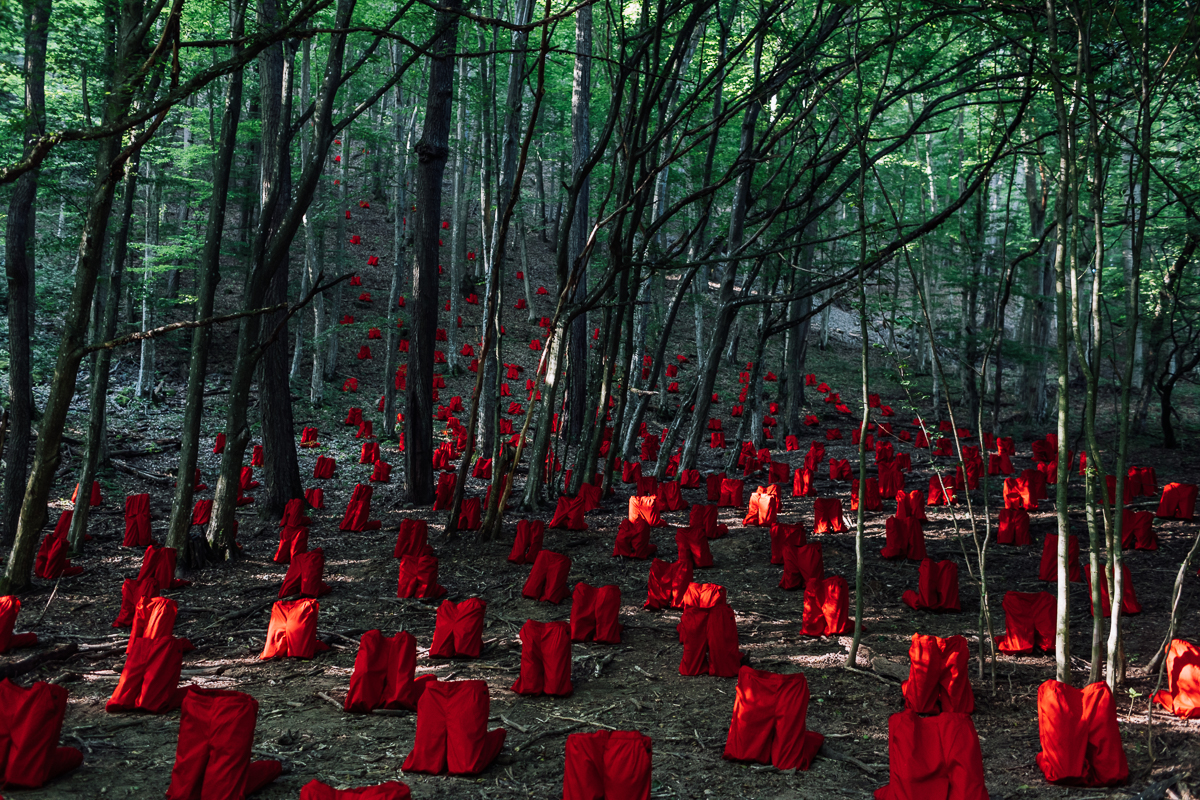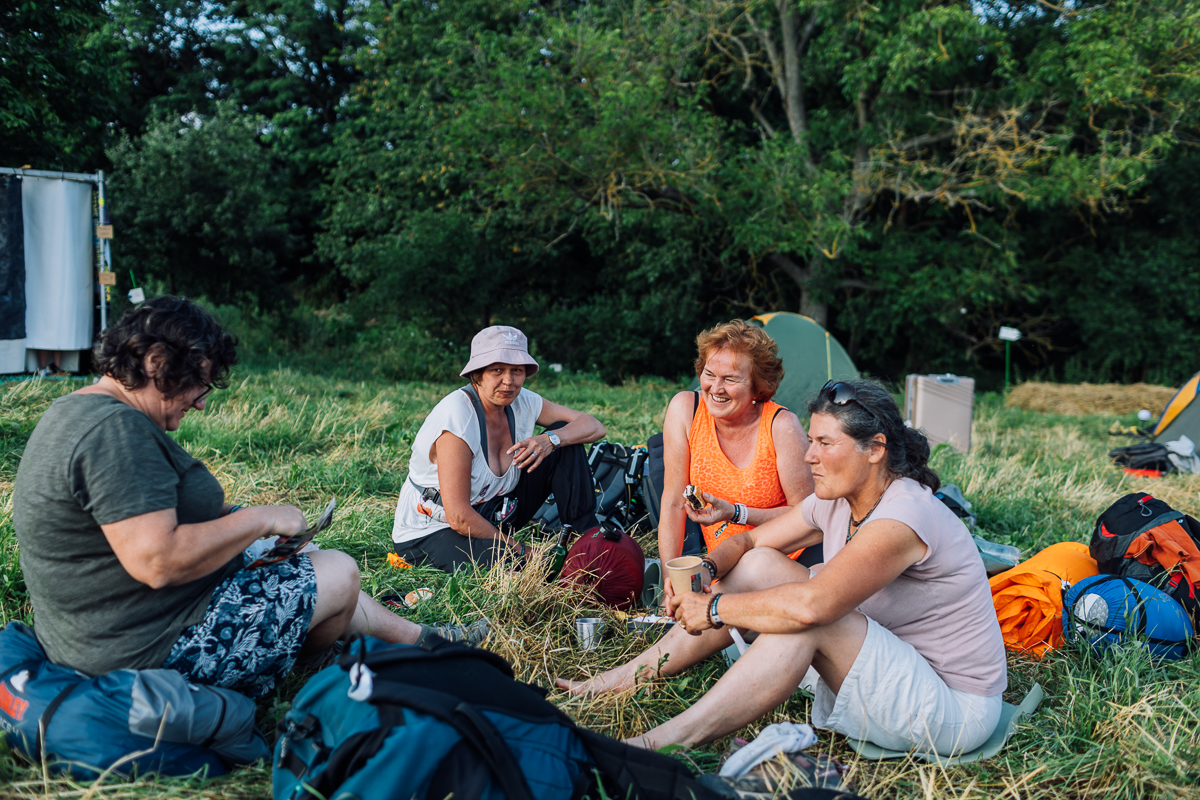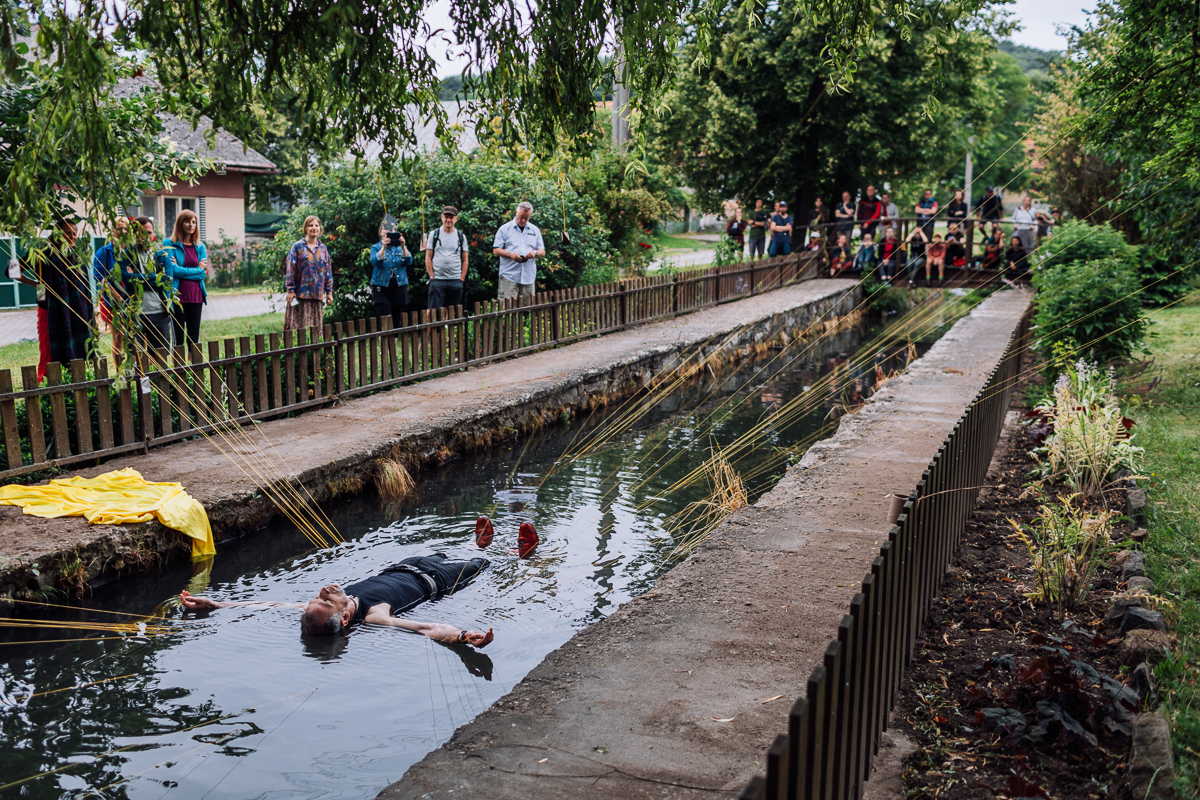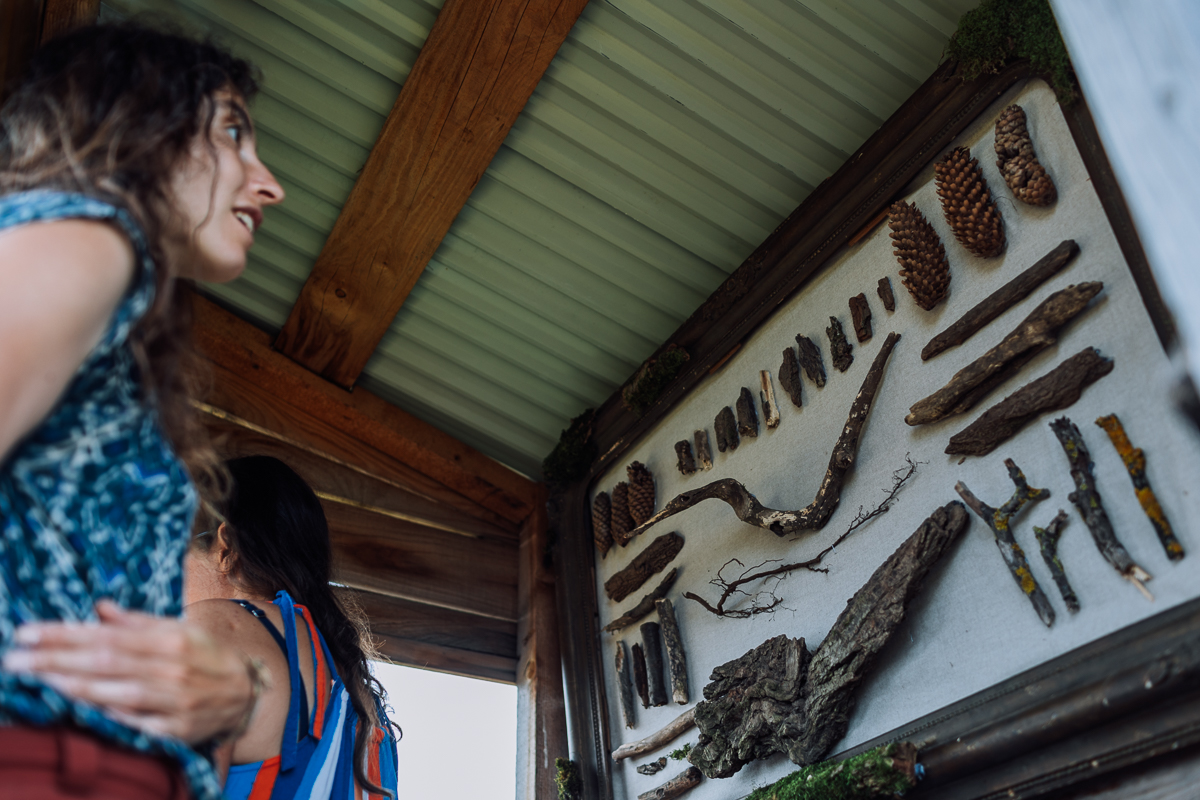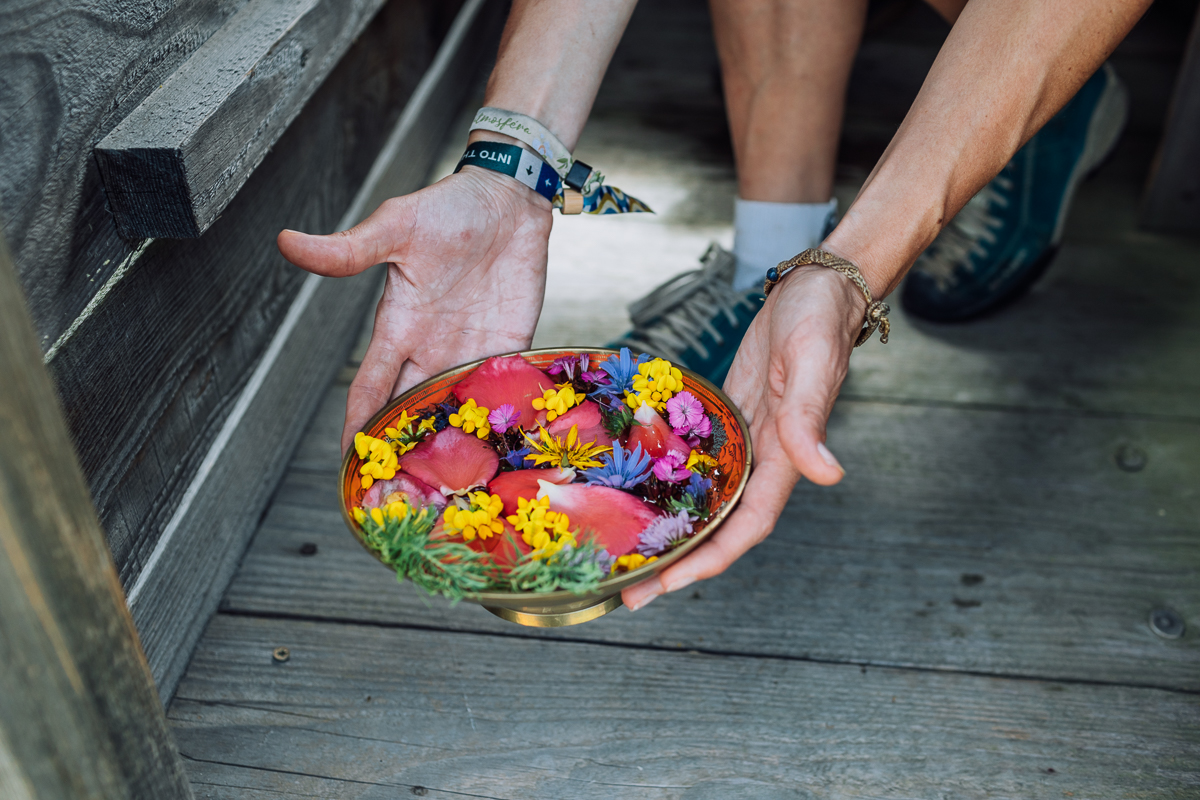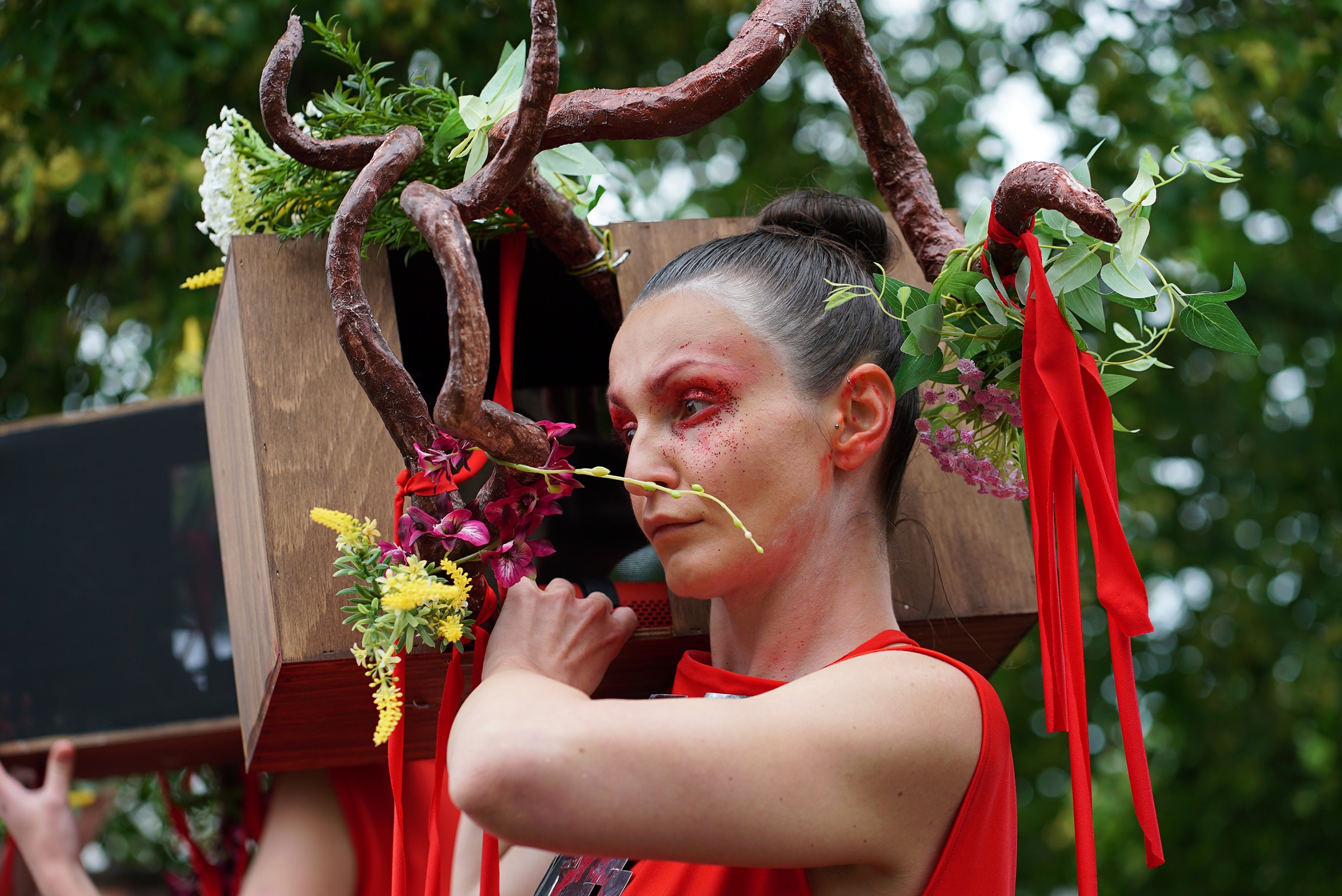Reconnecting with nature
Into the Miracles
Resurrection of Miracles: Developing a New Model for Art Festivals in the Slovak Countryside
Into the Miracles was an innovative art festival redefining cultural experiences in the Slovak countryside. Spanning an 80 km route through villages, forests, and meadows, audiences immersed themselves in site-specific artworks that seamlessly blended theater, dance, music, and visual arts with the natural landscape. By uniting people, art, and the environment, the festival fostered sustainability, reflection, and a deeper bond with the natural world - harmony between people and environment.
Slovakia
Regional
The festival was placed in region of Banska Bystrica.
Mainly rural
It refers to other types of transformations (soft investment)
Yes
2023-12-31
No
No
No
As a representative of an organisation
Festival "Into the Miracles was an innovative initiative designed to reconnect audience with nature through art, community engagement, and the exploration of cultural and natural richness in the Slovak countryside. Spanning an 80 km route, the festival transformed rural areas into stages for 82 site-specific artworks, celebrating the unique identity of the landscape and fostering a deeper connection between people and their environment.
The project’s primary aim was to develop a new model for art festivals that promotes sustainability, cultural enrichment, and regional identity. It sought to raise environmental awareness, strengthen the sense of belonging, and provide access to contemporary art for underrepresented rural communities.
Target groups of the project:
- Audiences: participants who participated in the full journey, partial routes, or viewed selected productions.
- Artists: professional artists and art students from 6 countries who contributed with innovative site-specific artworks for the festival.
- Local Communities: Residents of participating villages actively engaged in festival implementation.
We are convinced that our festival belongs to category of projects which reconnect people with nature. We also believe that our festival´s concept meets the NEB values and working principles. We describe it in following chapters of our application.
Festival "Into the Miracles" highlighted the potential of art to address pressing societal challenges, such as environmental issues and war conflict in Ukraine. Also, by drawing attention to less touristically developed area, it promoted the options of sustainable tourism and similar nature-based cultural events in the region, with a potential to strengthen local economies.
The festival was implemented in cooperation with partners from local, regional, national and international level.
The project’s primary aim was to develop a new model for art festivals that promotes sustainability, cultural enrichment, and regional identity. It sought to raise environmental awareness, strengthen the sense of belonging, and provide access to contemporary art for underrepresented rural communities.
Target groups of the project:
- Audiences: participants who participated in the full journey, partial routes, or viewed selected productions.
- Artists: professional artists and art students from 6 countries who contributed with innovative site-specific artworks for the festival.
- Local Communities: Residents of participating villages actively engaged in festival implementation.
We are convinced that our festival belongs to category of projects which reconnect people with nature. We also believe that our festival´s concept meets the NEB values and working principles. We describe it in following chapters of our application.
Festival "Into the Miracles" highlighted the potential of art to address pressing societal challenges, such as environmental issues and war conflict in Ukraine. Also, by drawing attention to less touristically developed area, it promoted the options of sustainable tourism and similar nature-based cultural events in the region, with a potential to strengthen local economies.
The festival was implemented in cooperation with partners from local, regional, national and international level.
Nature
Sustainability
Art
Community
Participation
Festival was designed to host a large-scale cultural event in a natural environment with minimal tourist infrastructure. Held along an 80 km trail in nature, it required creative solutions to provide participants with essential amenities, including sleeping arrangements, food, showers, and toilets.
Four simple tent camps were built using sustainable principles, with showers constructed from recycled materials and operating with cold water to conserve resources. Partnerships with small Slovak companies who produce eco friendly amenities allowed us to distribute eco-friendly soaps, shampoos, and toothpaste to our participants, ensuring minimal ecological impact. Tent camps were lit with solar-powered lighting, and each participant carried a portable solar lamp during hikes to later use it the camp at night.
Majority of food was sourced from local farmers and producers, with a strong emphasis on regional products and predominantly vegan meals, significantly reducing the festival's ecological footprint. Participants were encouraged to bring reusable food containers and bottles, supporting a zero-waste policy. Bus transport was provided to reduce the carbon footprint associated with travel.
Additionally, many artists embraced sustainability not only through the themes of their works, which addressed topics like nature, environmental protection, and ecological challenges, but also in their creative process. They used recycled and natural materials to craft the artworks for the festival.
By integrating sustainable practices into every aspect of its operations and artistic expressions, the festival served as a replicable model for cultural events in rural and natural settings. Its approach not only reduced environmental impact but also raised awareness about the importance of protecting nature.
Project was presented as a model of good practice at "Results and Sustainability of Cultural Programmes and Projects" event, organized by EEA Grants in Romania in June 2024.
Four simple tent camps were built using sustainable principles, with showers constructed from recycled materials and operating with cold water to conserve resources. Partnerships with small Slovak companies who produce eco friendly amenities allowed us to distribute eco-friendly soaps, shampoos, and toothpaste to our participants, ensuring minimal ecological impact. Tent camps were lit with solar-powered lighting, and each participant carried a portable solar lamp during hikes to later use it the camp at night.
Majority of food was sourced from local farmers and producers, with a strong emphasis on regional products and predominantly vegan meals, significantly reducing the festival's ecological footprint. Participants were encouraged to bring reusable food containers and bottles, supporting a zero-waste policy. Bus transport was provided to reduce the carbon footprint associated with travel.
Additionally, many artists embraced sustainability not only through the themes of their works, which addressed topics like nature, environmental protection, and ecological challenges, but also in their creative process. They used recycled and natural materials to craft the artworks for the festival.
By integrating sustainable practices into every aspect of its operations and artistic expressions, the festival served as a replicable model for cultural events in rural and natural settings. Its approach not only reduced environmental impact but also raised awareness about the importance of protecting nature.
Project was presented as a model of good practice at "Results and Sustainability of Cultural Programmes and Projects" event, organized by EEA Grants in Romania in June 2024.
Spanning 80 kilometers, the festival used the natural environment not just as a setting but as an essential part of the artistic experience. Its 82 site-specific installations and productions were designed to enhance the beauty and significance of the rural landscape, transforming villages, forests, and meadows into cultural stages. Artists participating in the project were invited to explore the theme of "Miracles," which they interpreted freely, producing artworks in diverse genres such as theater, dance, performance, visual arts, design, music, multimedia and poetry.
The variety of motives and genres offered to audiences an immersive journey through creative interpretations of miracles, blending tangible and abstract forms.
Walking was central to the festival experience, with participants engaging with the artworks in a meditative process that heightened their connection to both art and the surrounding landscape. This journey encouraged reflection and contemplation, combining the experience of beauty, physical effort, and mental rejuvenation.
The festival gained significant recognition, with cultural experts naming it one of Slovakia's most important cultural events of 2023. Among its supporters was Miroslav Ballay, a respected academic and researcher, who attended the festival journey and later authored a 60-page study analyzing its aesthetics and artistic communication. His research highlighted the innovative use of nature as a core element of the festival, the transformative impact of its site-specific works, and its ability to foster profound connections between participants, art, and the environment.
Ballay’s study not only documents the festival but establishes it as a cultural and artistic milestone. By offering a unique model for integrating art, nature, and community, "Into the Miracles" has become a benchmark for future initiatives that seek to inspire, connect, and engage with pressing societal and environmental themes.
The variety of motives and genres offered to audiences an immersive journey through creative interpretations of miracles, blending tangible and abstract forms.
Walking was central to the festival experience, with participants engaging with the artworks in a meditative process that heightened their connection to both art and the surrounding landscape. This journey encouraged reflection and contemplation, combining the experience of beauty, physical effort, and mental rejuvenation.
The festival gained significant recognition, with cultural experts naming it one of Slovakia's most important cultural events of 2023. Among its supporters was Miroslav Ballay, a respected academic and researcher, who attended the festival journey and later authored a 60-page study analyzing its aesthetics and artistic communication. His research highlighted the innovative use of nature as a core element of the festival, the transformative impact of its site-specific works, and its ability to foster profound connections between participants, art, and the environment.
Ballay’s study not only documents the festival but establishes it as a cultural and artistic milestone. By offering a unique model for integrating art, nature, and community, "Into the Miracles" has become a benchmark for future initiatives that seek to inspire, connect, and engage with pressing societal and environmental themes.
The "Into the Miracles" festival was designed with a strong commitment to inclusion, ensuring accessibility, affordability, and engagement for diverse audiences. The project aimed to create a cultural experience that was welcoming and impactful for all, regardless of physical ability or economic background.
Despite being primarily based on walking an 80-kilometer route, the festival addressed the needs of people with limited mobility by strategically placing many of the artworks in villages, ensuring that these installations and performances were easily accessible. This approach allowed individuals who could not participate in the entire walking route to still experience the festival.
While the festival operated with a business model that required ticket sales to sustain its services and infrastructure, significant efforts were made to ensure that economic barriers did not exclude local residents. Residents of participating villages were granted free access to the artworks and performances in their communities. This decision was motivated by two key objectives: to provide access to contemporary art experiences to those in rural areas who might not otherwise encounter such events and to include individuals from economically disadvantaged backgrounds.
Moreover, we did not only engage local communities as audiences but also involved them in the festival's implementation, creating a collaborative atmosphere and a sense of shared ownership. Local communtities and local authorities played vital part in festival´s implementation and its success.
We hope that accessibility-focused design, affordability for underserved communities, and collaborative ethos of festival demonstrate a replicable model for creating art experiences that break down barriers and bring people together.
Despite being primarily based on walking an 80-kilometer route, the festival addressed the needs of people with limited mobility by strategically placing many of the artworks in villages, ensuring that these installations and performances were easily accessible. This approach allowed individuals who could not participate in the entire walking route to still experience the festival.
While the festival operated with a business model that required ticket sales to sustain its services and infrastructure, significant efforts were made to ensure that economic barriers did not exclude local residents. Residents of participating villages were granted free access to the artworks and performances in their communities. This decision was motivated by two key objectives: to provide access to contemporary art experiences to those in rural areas who might not otherwise encounter such events and to include individuals from economically disadvantaged backgrounds.
Moreover, we did not only engage local communities as audiences but also involved them in the festival's implementation, creating a collaborative atmosphere and a sense of shared ownership. Local communtities and local authorities played vital part in festival´s implementation and its success.
We hope that accessibility-focused design, affordability for underserved communities, and collaborative ethos of festival demonstrate a replicable model for creating art experiences that break down barriers and bring people together.
The "Into the Miracles" festival was developed since 2021 —with partners from Slovakia, Norway, Iceland, and Liechtenstein— as a collaborative cultural experiment, aimed at creating a new model for art events.
The involvement of audience, artists, culture operators, volunteers and locals was not only crucial but integral to the festival’s success.
To ensure smooth logistics and organization, professionals from cultural management, event planning, and art production—key figures in Slovakia’s civil society within the arts—were actively engaged.
Additionally, 30 young volunteers from Slovakia, the Czech Republic, and Ukraine contributed to the preparation, realization, and follow-up of the event.
The local community played an equally vital role, not just as spectators but as active contributors. Many residents volunteered in organization, logistics, and promotion, while local farmers opened their farm gate sales and others prepared meals for participants passing through their villages. In several locations, senior women baked traditional pies and cakes, offering them as refreshments, fostering meaningful connections between locals, artists, and audiences.
For the participating artists, the festival provided a unique platform to showcase their work while fostering networking and collaboration with peers from various countries.
The audience itself played a central role, particularly the 100 "pilgrims" who walked the 80-kilometer route over four days. These participants engaged deeply with the walk, transforming the festival into a shared journey that combined art, nature, and physical endurance. Along the way, they shared meals, conversations, and experiences of tiredness and achievement, forming a close-knit community.
This collaborative involvement demonstrated the power of art to unite and inspire diverse groups, offering a replicable model for future cultural initiatives.
The involvement of audience, artists, culture operators, volunteers and locals was not only crucial but integral to the festival’s success.
To ensure smooth logistics and organization, professionals from cultural management, event planning, and art production—key figures in Slovakia’s civil society within the arts—were actively engaged.
Additionally, 30 young volunteers from Slovakia, the Czech Republic, and Ukraine contributed to the preparation, realization, and follow-up of the event.
The local community played an equally vital role, not just as spectators but as active contributors. Many residents volunteered in organization, logistics, and promotion, while local farmers opened their farm gate sales and others prepared meals for participants passing through their villages. In several locations, senior women baked traditional pies and cakes, offering them as refreshments, fostering meaningful connections between locals, artists, and audiences.
For the participating artists, the festival provided a unique platform to showcase their work while fostering networking and collaboration with peers from various countries.
The audience itself played a central role, particularly the 100 "pilgrims" who walked the 80-kilometer route over four days. These participants engaged deeply with the walk, transforming the festival into a shared journey that combined art, nature, and physical endurance. Along the way, they shared meals, conversations, and experiences of tiredness and achievement, forming a close-knit community.
This collaborative involvement demonstrated the power of art to unite and inspire diverse groups, offering a replicable model for future cultural initiatives.
The festival was made possible through the collaboration of stakeholders at local, regional, national, and international levels, each playing a role in its design or implementation.
At the local level, partnerships with municipalities along the festival route were essential. Their approval and active support ensured the smooth execution of the event, as they provided local knowledge, material resources, spaces, and personnel. This involvement grounded the festival in the community, fostering a strong connection between the event and its local setting.
Regionally, parishes enabled the use of churches and bell towers as venues for installations, enriching the festival’s cultural and spiritual dimensions. Also, regional railways granted access to abandoned train stations, which allowed us to transform them into unique spaces for performances and exhibitions. By this, we were able to highlight the area’s character and heritage.
Being funded through EEA Grants, which are coordinated by the Ministry of Investment, Regional Development, and Informatization of the Slovak Republic, the Ministry became our partner on national lever, who oversaw the project throughout its duration, ensuring it aligned with the grant’s goals.
We also developed a sponsorship partnerships with several Slovak firms, who shared the same values and wanted to support us.
On the international level, the EEA Grants framework facilitated collaboration with professional cultural organizations from Norway, Liechtenstein, and Iceland. These partners played a key role in shaping the project, sharing expertise, and nominating artists who created artworks for the festival.
At the local level, partnerships with municipalities along the festival route were essential. Their approval and active support ensured the smooth execution of the event, as they provided local knowledge, material resources, spaces, and personnel. This involvement grounded the festival in the community, fostering a strong connection between the event and its local setting.
Regionally, parishes enabled the use of churches and bell towers as venues for installations, enriching the festival’s cultural and spiritual dimensions. Also, regional railways granted access to abandoned train stations, which allowed us to transform them into unique spaces for performances and exhibitions. By this, we were able to highlight the area’s character and heritage.
Being funded through EEA Grants, which are coordinated by the Ministry of Investment, Regional Development, and Informatization of the Slovak Republic, the Ministry became our partner on national lever, who oversaw the project throughout its duration, ensuring it aligned with the grant’s goals.
We also developed a sponsorship partnerships with several Slovak firms, who shared the same values and wanted to support us.
On the international level, the EEA Grants framework facilitated collaboration with professional cultural organizations from Norway, Liechtenstein, and Iceland. These partners played a key role in shaping the project, sharing expertise, and nominating artists who created artworks for the festival.
We developed the festival entirely from scratch, as its concept— to our knowledge—had no direct precedent or existing model. This necessitated the integration of expertise across a wide range of disciplines, fostering deep collaboration among professionals to design and implement an innovative and impactful event.
From the outset, the festival was shaped by the expertise of production managers, cultural managers, dramaturges, curators, event managers, and PR and marketing specialists. These cultural operators played a vital role in conceptualizing and coordinating the festival, managing its logistics, curating the artistic program, and ensuring effective communication and audience engagement.
Artists from diverse genres—including theater, dance, performance art, visual arts, music, multimedia, literature, design, and architecture—were invited to participate later on. They were introduced to the festival’s concept and theme, and given the freedom to interpret it creatively, experimenting with new forms and topics to produce site-specific works. To support their creative processes, we provided them with materials, workspace, promotional platforms and artist in residence program.
The selection of the festival route required collaboration with local active hiking enthusiasts familiar with the area, as well as keepers of the tourist trails who are responsible for maintaining and marking tourist trails. Thanks to them we could choose the route that was both safe and integrated seamlessly into the natural environment.
Local communities also played an essential role, offering practical support and sharing historical and cultural knowledge about the locations. Their insights allowed the festival to incorporate the stories and significance of the landscape into the broader artistic context.
To ensure safety of participants, we worked closely with a first-aid provider, who helped design prevention and intervention measures tailored to the event’s unique demands.
From the outset, the festival was shaped by the expertise of production managers, cultural managers, dramaturges, curators, event managers, and PR and marketing specialists. These cultural operators played a vital role in conceptualizing and coordinating the festival, managing its logistics, curating the artistic program, and ensuring effective communication and audience engagement.
Artists from diverse genres—including theater, dance, performance art, visual arts, music, multimedia, literature, design, and architecture—were invited to participate later on. They were introduced to the festival’s concept and theme, and given the freedom to interpret it creatively, experimenting with new forms and topics to produce site-specific works. To support their creative processes, we provided them with materials, workspace, promotional platforms and artist in residence program.
The selection of the festival route required collaboration with local active hiking enthusiasts familiar with the area, as well as keepers of the tourist trails who are responsible for maintaining and marking tourist trails. Thanks to them we could choose the route that was both safe and integrated seamlessly into the natural environment.
Local communities also played an essential role, offering practical support and sharing historical and cultural knowledge about the locations. Their insights allowed the festival to incorporate the stories and significance of the landscape into the broader artistic context.
To ensure safety of participants, we worked closely with a first-aid provider, who helped design prevention and intervention measures tailored to the event’s unique demands.
Unlike conventional art festivals held in urban settings or dedicated venues, Into the Miracles unfolded along an 80-kilometer route through the Slovak countryside. Nature was a vital part of the festival’s design. Site-specific artworks harmonized with the landscapes, transforming meadows, forests, villages, and landmarks into cultural spaces, redefining how audiences engage with art and the natural environment.
Most artworks were newly created specifically for the festival. Participating artists engaged in an artist-in-residence program, studying the local environment, culture, and history to inform their creations and ensure they resonated deeply with the region.
Unlike mainstream festivals, Into the Miracles involved participants as active co-creators. Walking the route encouraged a meditative connection with the artworks, creating a transformative experience.
Additionaly, local communities were integral, offering practical support, sharing cultural and historical knowledge, and contributing through farm gate sales, food preparation, and hospitality.
Into the Miracles prioritized sustainability over spectacle. Recycled and natural materials were used for artworks, and many eco-friendly measures were implemented so that the event could be "as green as possible".
Developed entirely from scratch in a rural setting with minimal infrastructure, Into the Miracles relied on innovative solutions, such as temporary tent camps, local food providers, and first-aid planning for remote areas. Its success highlights how resourceful planning and community collaboration can overcome logistical challenges to deliver a meaningful and sustainable cultural experience.
Most artworks were newly created specifically for the festival. Participating artists engaged in an artist-in-residence program, studying the local environment, culture, and history to inform their creations and ensure they resonated deeply with the region.
Unlike mainstream festivals, Into the Miracles involved participants as active co-creators. Walking the route encouraged a meditative connection with the artworks, creating a transformative experience.
Additionaly, local communities were integral, offering practical support, sharing cultural and historical knowledge, and contributing through farm gate sales, food preparation, and hospitality.
Into the Miracles prioritized sustainability over spectacle. Recycled and natural materials were used for artworks, and many eco-friendly measures were implemented so that the event could be "as green as possible".
Developed entirely from scratch in a rural setting with minimal infrastructure, Into the Miracles relied on innovative solutions, such as temporary tent camps, local food providers, and first-aid planning for remote areas. Its success highlights how resourceful planning and community collaboration can overcome logistical challenges to deliver a meaningful and sustainable cultural experience.
The methodology of the Into the Miracles project was rooted in a multidisciplinary, participatory, and sustainable approach, ensuring every aspect of the festival embodied inclusivity, creativity, and environmental responsibility.
The project brought together expertise from diverse fields, including cultural management, artistic disciplines, environmental science, and community engagement. Cultural operators worked closely with artists across a wide range of genres, creating a cohesive and innovative program that celebrated the unique cultural and natural heritage of the Slovak countryside.
From the outset, Into the Miracles prioritized the involvement of artists, local communities, and audiences. The artist-in-residence program provided creators with the opportunity to immerse themselves in the local environment, culture, and history, allowing their works to authentically resonate with the region.
Sustainability was a guiding principle of the project. The use of recycled and natural materials for artworks, solar-powered lighting, and robust waste-reduction measures highlighted the festival’s commitment to environmental consciousness. Collaborations with eco-conscious Slovak companies strengthened these efforts.
Developed entirely from scratch in a rural setting with minimal infrastructure, the festival employed innovative solutions to address logistical challenges. Temporary services, carefully designed to align with sustainable and local principles, supported participants throughout the 80-kilometer journey, showcasing how resourceful planning and collaboration can create a meaningful cultural experience.
The project brought together expertise from diverse fields, including cultural management, artistic disciplines, environmental science, and community engagement. Cultural operators worked closely with artists across a wide range of genres, creating a cohesive and innovative program that celebrated the unique cultural and natural heritage of the Slovak countryside.
From the outset, Into the Miracles prioritized the involvement of artists, local communities, and audiences. The artist-in-residence program provided creators with the opportunity to immerse themselves in the local environment, culture, and history, allowing their works to authentically resonate with the region.
Sustainability was a guiding principle of the project. The use of recycled and natural materials for artworks, solar-powered lighting, and robust waste-reduction measures highlighted the festival’s commitment to environmental consciousness. Collaborations with eco-conscious Slovak companies strengthened these efforts.
Developed entirely from scratch in a rural setting with minimal infrastructure, the festival employed innovative solutions to address logistical challenges. Temporary services, carefully designed to align with sustainable and local principles, supported participants throughout the 80-kilometer journey, showcasing how resourceful planning and collaboration can create a meaningful cultural experience.
The methodology of the "Into the Miracles" festival was rooted in a multidisciplinary, participatory, and sustainable approach, ensuring every aspect of the festival embodied inclusivity, creativity, and environmental responsibility.
The project brought together expertise from diverse fields, including cultural management, artistic disciplines, environmental practise, and community engagement. Cultural operators worked closely with artists across a wide range of genres, creating a cohesive and innovative program that celebrated the unique cultural and natural heritage of the Slovak countryside.
From the outset, Into the Miracles prioritized building bridges between the artists and local communities. The artist-in-residence program provided creators with the opportunity to immerse themselves in the local people, environment, culture, and history, allowing their works to authentically resonate with the region. Many of artists collected stories from local people by using oral history methodology. Some of them organised workshops and work in progress presentations of their artworks.
Sustainability was a guiding principle of the project. The use of recycled and natural materials for artworks, solar-powered lighting, and robust waste-reduction measures highlighted the festival’s commitment to environmental consciousness. Collaborations with eco-conscious Slovak companies strengthened these efforts.
Developed entirely from scratch in a rural setting with minimal infrastructure, the festival staff had to apply innovative solutions to address logistical challenges. Temporary services, carefully designed to align with sustainable and local principles, supported participants throughout the 80-kilometer journey, showcasing how resourceful planning and collaboration can create a meaningful cultural experience.
The project brought together expertise from diverse fields, including cultural management, artistic disciplines, environmental practise, and community engagement. Cultural operators worked closely with artists across a wide range of genres, creating a cohesive and innovative program that celebrated the unique cultural and natural heritage of the Slovak countryside.
From the outset, Into the Miracles prioritized building bridges between the artists and local communities. The artist-in-residence program provided creators with the opportunity to immerse themselves in the local people, environment, culture, and history, allowing their works to authentically resonate with the region. Many of artists collected stories from local people by using oral history methodology. Some of them organised workshops and work in progress presentations of their artworks.
Sustainability was a guiding principle of the project. The use of recycled and natural materials for artworks, solar-powered lighting, and robust waste-reduction measures highlighted the festival’s commitment to environmental consciousness. Collaborations with eco-conscious Slovak companies strengthened these efforts.
Developed entirely from scratch in a rural setting with minimal infrastructure, the festival staff had to apply innovative solutions to address logistical challenges. Temporary services, carefully designed to align with sustainable and local principles, supported participants throughout the 80-kilometer journey, showcasing how resourceful planning and collaboration can create a meaningful cultural experience.
Climate change and environmental degradation require actions to reduce resource consumption, waste, and environmental impact.
Into the Miracles as a local event prioritized sustainability by integrating eco-friendly practices (previously described in detail) into every aspect of its design.
Increasing urbanization and digital dependency have led to a growing disconnect from nature, impacting mental and physical well-being. However, our festival encouraged a deep reconnection with nature by integrating walking as a central element. This format provided a counterbalance to modern, fast-paced lifestyles, promoting well-being and environmental awareness.
Rural areas often face cultural and economic marginalization, with limited access to contemporary art and opportunities for cultural engagement.
As a solution, by transforming an 80-kilometer rural route into a vibrant cultural space, the festival brought high-quality, site-specific artworks to regions where such experiences are rare.
Socioeconomic inequalities often exclude certain groups from participating in cultural experiences. As a solution, we ensured accessibility for local residents by offering free access to installations in their villages.
Into the Miracles as a local event prioritized sustainability by integrating eco-friendly practices (previously described in detail) into every aspect of its design.
Increasing urbanization and digital dependency have led to a growing disconnect from nature, impacting mental and physical well-being. However, our festival encouraged a deep reconnection with nature by integrating walking as a central element. This format provided a counterbalance to modern, fast-paced lifestyles, promoting well-being and environmental awareness.
Rural areas often face cultural and economic marginalization, with limited access to contemporary art and opportunities for cultural engagement.
As a solution, by transforming an 80-kilometer rural route into a vibrant cultural space, the festival brought high-quality, site-specific artworks to regions where such experiences are rare.
Socioeconomic inequalities often exclude certain groups from participating in cultural experiences. As a solution, we ensured accessibility for local residents by offering free access to installations in their villages.
The Into the Miracles project achieved significant outcomes and impacts, demonstrating its innovative approach to integrating art, nature, and community. Below are the most notable outcomes, results, and impacts:
- Cultural Innovation: featuring an 80-kilometer trail with 82 artist interventions, the festival redefined audience engagement by integrating art and nature. Participants experienced a deeply participatory and meditative journey that combined cultural enrichment with environmental awareness.
- Environmental Responsibility: by encouraging participants to walk through natural landscapes, the project fostered a profound connection with the environment. Organizers and artists adopted environmentally friendly measures, including the use of recycled materials, natural resources, and eco-conscious practices.
- Community Building: local communities were not just spectators but active collaborators in the festival’s success. Their involvement strengthened bonds between residents, artists, and audiences. The project also deepened collaboration between the organizing team and local authorities, with nine municipalities actively engaged.
- Contemporary Art in Rural Areas: the project introduced contemporary art to rural villages where such experiences are rare. Free access for local residents ensured inclusivity and allowed broader cultural engagement.
- Regional Visibility: the festival attracted visitors to less touristically developed regions, showcasing the area’s cultural and natural richness. This visibility positioned the region as a destination for future cultural initiatives and sustainable tourism.
- Inspiring the Cultural Sector: by presenting results and methodologies at international conferences and events, the project inspired cultural operators and artists to explore innovative ways of integrating art, nature, and community in their work.
- Cultural Innovation: featuring an 80-kilometer trail with 82 artist interventions, the festival redefined audience engagement by integrating art and nature. Participants experienced a deeply participatory and meditative journey that combined cultural enrichment with environmental awareness.
- Environmental Responsibility: by encouraging participants to walk through natural landscapes, the project fostered a profound connection with the environment. Organizers and artists adopted environmentally friendly measures, including the use of recycled materials, natural resources, and eco-conscious practices.
- Community Building: local communities were not just spectators but active collaborators in the festival’s success. Their involvement strengthened bonds between residents, artists, and audiences. The project also deepened collaboration between the organizing team and local authorities, with nine municipalities actively engaged.
- Contemporary Art in Rural Areas: the project introduced contemporary art to rural villages where such experiences are rare. Free access for local residents ensured inclusivity and allowed broader cultural engagement.
- Regional Visibility: the festival attracted visitors to less touristically developed regions, showcasing the area’s cultural and natural richness. This visibility positioned the region as a destination for future cultural initiatives and sustainable tourism.
- Inspiring the Cultural Sector: by presenting results and methodologies at international conferences and events, the project inspired cultural operators and artists to explore innovative ways of integrating art, nature, and community in their work.

